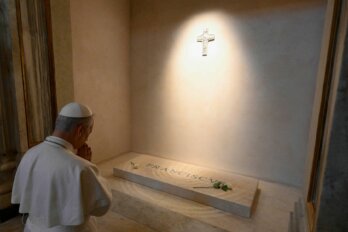June Callwood didn’t mince words when she told poet and critic M. NourbeSe Philip to “fuck off.” The scene was the 1989 PEN Congress in Toronto where Callwood—a journalist, social activist, and, at the time, PEN Canada’s incoming president—confronted Philip who, with other demonstrators, was picketing because of the lack of writers of colour at the meeting. This wasn’t the only time Philip would be attacked by a member of the Canadian establishment. In 1995, two years after helping to lead protests against a Toronto production of Show Boat—Philip accused the American musical, set after the end of the Civil War, of using its black characters to make “whites feel good about themselves”—she was denounced by writer Michael Coren on his radio show as a woman who had “done nothing but defecate upon this country.”
Philip describes herself as a “disappeared” writer who has paid the price for her activism with her erasure from Canadian literature. In a recent essay published in The Puritan, Kate Siklosi expertly demonstrates this disappearance and the “archive of silence around Philip and her work in Canada.” While many of her contemporaries have taken up comfortable positions as creative-writing instructors or editors in publishing houses, Philip has yet to find prominent footing in the larger CanLit scene. Outside the country, she has been given the Casas de las Américas prize and a Guggenheim Fellowship among other international honours, but she has never received any major national literary award at home. Her 2008 collection, Zong!—about the 1781 murder of Africans thrown overboard on the orders of a slave-ship captain—was mostly ignored by Canadian critics despite being praised around the world.
Given Philip’s polemicism and her poly-vocal experiments with form, it might not be surprising that she would be seen as an outsider to the tonier CanLit communities. What is surprising is the extent to which she is also missing from the contemporary debates that have transformed CanLit. Philip’s history of disruption is directly relevant to our current discussions over cultural appropriation, antiblack racism, and exploitation in Canadian literature and publishing. Yet it’s hard to find major essays on the current state of CanLit that make reference to her work, she has been notably absent from panels discussing the topic, and isn’t a contributor to Refuse: CanLit in Ruins, the new anthology of criticism on the “raging dumpster fire” that has consumed the Canadian writing scene.
In a cruel twist of irony, Philip’s work seems to have been doubly disappeared by today’s emerging community of CanLit writers whose own arguments echo the critiques Philip has been making for years. When Alicia Elliot, in an important essay about the “stubborn, lagging institutions” that prop up Canadian literature, asks, “How is CanLit continually making the same mistakes?,” a clear answer is that we forget our history. Ignoring the work of critics like Philip, we stand to repeat the same struggles.
It is in this context that Philip’s new collection of essays, letters, and interviews, Bla_k, is a rich and necessary addition to the Canadian cultural and literary conversation. Bla_k is a series of essays on topics ranging from criticism on art, politics, and race to more poetic meditations on black life in the Americas. Philip’s work fills in many gaps in the historical record—linking, for instance, today’s cultural-appropriation debates with the splitting of the Women’s Press in 1988 over white writers appropriating the voice of nonwhite characters. She reminds readers of the 1984 decision of the League of Canadian Poets to refuse entry to dub poets Lillian Allen, Clifton Joseph, and Devon Haughton on the grounds that they were “performers” rather than “poets.” Philip uses the historical record to enrich today’s debates. “What surprised me in the response to the Boyden matter in 2016,” she writes, referring to the controversy over novelist Joseph Boyden’s claims of Indigenous ancestry, “was the sole focus on issues of identity, almost to the exclusion of all others. There was no reference to the 1984 debate that had raged across Canada’s literary community.” For Philip, such forgetfulness encourages “greater erasure” around issues related to racism.
Her analysis of cultural appropriation is both surprising and convincing. She argues that prohibiting white writers from adopting the voice of an “Other” is not only impractical and unenforceable but that it “alters not one iota of that invisible and sticky web of systematic or structural racism. If all the white writers interested in this type of writing were voluntarily to swear off writing from the point of view of persons from other races and/or cultures, it would not ensure that writers from those cultures or races would get published any more easily, or at all.” Philip is suspicious of symbolic victories and instead stresses the importance of material change in Canadian institutions. The debate about appropriation, she argues, is a stand-in for the debate we should be having: one about racism. Her real concern are white writers who want to enjoy the privilege to use any voice or point of view they choose but who are reluctant to upset the structures that silence marginalized writers.
Philip describes herself as a “long-memoried woman,” who employs historical consciousness to understand the root causes of today’s debates. Her relationship to memory is present in the title of her book where the missing letter in Bla_k evokes how being black in Canada is to always live under erasure, as well as the manner in which Canada, and Canadian literature, sees itself as a “blank” canvas, feigning ignorance of its history. Many of the essays in Bla_k appeared in Philip’s earlier collections, but with almost every piece, she includes a coda that offers a reflection on the original work. She observes that it is a “disconcerting and disturbing experience to reread my own thoughts, opinions and conclusions on the racism permeating the institutions of Canada…and to reflect on how little has changed over the years.”
The double meaning of blank/black also speaks to Philip’s struggle to contend with the enforced silences she has encountered. She explains that, when she arrived “in Canada, it felt as if there was not a tradition that I could engage with—either in embrace or rejection” and that “after twenty-five years, I’m still hunting, trying to find the word or words to describe the Middle Passage, site of so much grief and trauma, final home to so many of us.” Part of her effort to contend with the “rupture that is Africa and the Caribbean” in Western history is to both “acknowledge the silence” while paying heed to the poet’s impulse for a language to describe that silence. “The question is, do you—should you—turn the horror of a particular history into something beautiful?” This question, ultimately about a writer’s responsibility to her audience, haunts Philip throughout the collection as she meditates on the relationship between politics and poetic voice, the history of colonialism and contemporary questions of race, and the place of blackness in Canada.
A trained lawyer and successful poet, Philip brings both sensibilities to bear on her topics—topics which include her skepticism toward any kind of settled identity or simple notion of belonging. Philip was born in Tobago, and in “Echoes in a Stranger Land,” she offers a cautious statement about her own affinity to her adopted nation: “I have for the last twenty-give years—almost—made Canada my home, another word of apparent fixity yet also subject to a dangerous fluidity.” Philip aims to locate this dangerous fluidity that lies beneath the surface of any articulation of belonging. “I write memory on the margins of history,” she explains, “in the shadow of empire and on the frontier of Silence; I write against the grain as an unembedded, disappeared poet and writer in Canada.” Yet even as she excoriates Canada for its history of racial injustice, she poses the question, “How do we lose the sense of being ‘othered,’ and how does Canada begin its m/othering of us who now live here, were born here, have given birth here—all under a darker sun?” It is refreshing to read a critic who resists the gesture to completely denounce the nation but instead dares to imagine how Canada might reckon with its own racism and be transformed from within.
In a few key essays, Philip’s prose soars to offer singular readings of poetry, blackness, nation, and voice. In “Caribana: African Roots and Continuities” she traces the origins of Caribana—now known as the Toronto Caribbean Carnival, held in the city each summer—from its roots in African and Caribbean forms of carnival to its more contemporary routes across Europe and the Americas. She locates the festival within slave celebrations and then transposes those histories onto Canada to show how the event temporarily opens spaces of black expression. Philip begins her prologue in the voice of the sociologist, explaining that “Black bodies in public spaces are always policed and restricted.” She also explains that because some “experiences demand a faithfulness to the language in which the experience happens” she decided to write in Trinidadian creole, a language she praises for its “kinetic qualities”—or for how it “brings over into English ‘the relationship between the dynamics of speech and the dynamics of action.’” Philip then demonstrates the liberating power of such dynamic language, performing the very creolizing transformation she calls for. Using her “all mix up mix up” voice, she follows the figures of Maisie and Totoben as they dance in the Caribana parade up University Avenue and back in time to Caribbean plantations and the slave ships of the Middle Passage: “push and shove and jostle and shove and move hip sway hip wine in your wine and look how we enjoying we self—move hip sway hip slap hip big hip fat hip flat bottom big bottom sweet bottom wine-your-waist bottom.”
The language of social critique gives way to vibrant demotic—the language of what Philip calls “tongue licking up against tongue”—to provide a vision of escaping the policing and restricting of black creative expression.
In one of the most challenging pieces, “Dis-Place The Space Between,” Philip reflects on her own early work, she wonders, “why did the poet write herself—the female body—out of place, the public space of the text? Why did she impose the sentence of silence on herself?” This interrogation of her self-silencing leads her to wonder how she can link the inner and outer spaces of the self without falling on stereotypical or demeaning depictions. She explores the question with a sprawling, poly-vocal, cross-genre reflection organized around a depiction of a community of Jamette’s, a patois word for women from society’s fringes: “Jamette! A loose woman, a woman of loose morals, whose habitat is the street. Jamette! A woman possessing both the space between her legs and the space around her, knowing her place.” This is a complicated essay that jumps from historical analysis to dramatic representation to poetic reflection all to show that “women are raced. And so too their space. Inner and outer.”
In another impressive essay which also connects our history to our present, Philip reflects upon the Into the Heart of Africa controversy at the Royal Museum of Ontario. The 1989 exhibit featured objects and images from soldiers and missionaries who had visited Africa in Victorian and Edwardian times (artifacts included a photograph of a British soldier stabbing a Zulu warrior in the chest). Museum staff defended Into the Heart of Africa as a critical examination of the damage inflicted on Africans, but critics, led by members of the city’s black community, said the exhibit glorified imperialism and they denounced it as racist. In her essay, Philip deconstructs the words of ROM’s guest curator Jeanne Cannizzo and turns the museum’s ignorance against itself. Cannizzo makes the case in the exhibit’s catalogue that “by studying the museum as an artifact, reading collections as cultural texts, and discovering life histories of objects, it has become possible to understand something of the complexities of cross-cultural encounters.” For Philip, this a poor explanation for the museum’s misrepresentation of African culture. Philip flips Cannizzo’s words, offering a point-by-point rebuttal while also holding a mirror up to the museum itself. The institution called for people to look at the exhibit with fresh eyes but failed to see that the exhibit itself exposed the museum as a extension of colonial power. Philip analyzes “the museum as an artifact” in order to demonstrate that “the ethnographic ‘Other’ in this case was the white Canadian fossilized in his or her bed of unconscious racism.” The cross-cultural encounter, Philip argues, “went in one direction.”
In a Canadian literary landscape that too often forgets to look back, Philip offers a model of a critic and public intellectual whose practice is founded on insight, careful reading, and reasoned argument. Embodying American writer James Baldwin’s assertion that “artists are here to disturb the peace,” Philip’s newest collection is a profound disturbing of our peace. May we have the sense to listen and remember with her.





